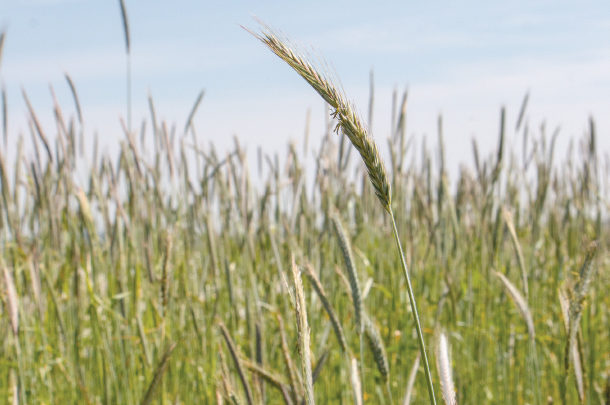Feeding during this time period could last for 90 to 180 days based on individual management programs, resources and weather conditions.
Winter feed costs are a large expense for many cattle producers. Thus, alternative winter feeding programs need to be evaluated to reduce the cost of winter feeding while meeting the nutritional needs of cattle. Grazing cool-season annual forages is one of those alternatives that may provide producers with a cost-effective way to reduce hay, supplement and stored feed costs while potentially extending the grazing season by three or more months.
Cool-season annual forages can be an important part of forage production systems as they allow dormant warm-season perennial pastures to be utilized. These acres would normally be nonproductive during the winter months but can become productive acres during the winter and early spring months.
Although cool-season annual forages are costly to establish ($125 to $300 per acre depending on planting method and fertilization), their nutritive values are high in total digestible nutrients (TDN) and crude protein (CP). The high nutritive value of cool-season annual forages can provide cattle producers with a less costly substitute for supplementing their herd’s nutritional needs.
The cost of establishment, amount of forage production and level of forage utilization are three important factors in determining the economics of planting and grazing cool-season annual forages. Producer results for these three key variables can vary greatly across the Southeastern U.S. Table 1 provides an analysis of cool-season annual forage cost per dry matter ton consumed ($ per DM ton) for various levels of forage production and production cost per acre.

The first column in Table 1 describes the level of cool-season annual forage production per acre and ranges from 3,000 to 10,000 DM pounds per acre. Forage utilization or consumption of forage, as shown in the second column, was assumed to be 50 percent of the total available forage production.
Forage utilization in Table 1 ranges from 1,500 to 5,000 DM pounds per acre. The data in columns 3 through 10 represent the total cost of growing and grazing cool-season annual forages per DM ton consumed. As described in the interior of Table 1, the total cost of growing and grazing ranged from $50 to $400 per DM ton consumed.
A comparable-quality feedstuff (soyhulls, dried distillers grains [DDG] and bermudagrass hay) was purchased, mixed, stored and fed (adjusted for waste) for $185 per dry ton consumed to help producers determine under what levels of forage production, forage utilization and production cost per acre would growing and grazing cool-season annual forages reduce their winter feeding costs.
The highlighted areas in Table 2 show the possible combinations of forage production, forage utilization and production costs per acre that have a lower cool-season annual forage growing and grazing cost per DM ton consumed than for what a comparable-quality feedstuff could be consumed.

The analysis in Table 2 illustrates producers have numerous alternatives to economically grow and graze cool-season annual forages. Each producer must determine what values are attainable for their operation.
Table 3 provides a detailed view of the variables and equations used to determine the total cost of growing and grazing cool-season annual forages per DM ton consumed.
 A forage production level of 6,000 DM pounds per acre, forage utilization of 50 percent and a cool-season annual forage production cost of $175 per acre results in a total cost of growing and grazing cool-season annual forages of $117 per DM ton consumed.
A forage production level of 6,000 DM pounds per acre, forage utilization of 50 percent and a cool-season annual forage production cost of $175 per acre results in a total cost of growing and grazing cool-season annual forages of $117 per DM ton consumed.
The level of forage and feed utilization is a very important and often overlooked variable when determining the economics of winter feeding systems. Utilization measures the amount of forage or feed consumed by cattle. This provides us with the information to adjust for waste and calculate the total cost of using the feedstuff.
Regardless of the feedstuff used (cool-season annual forages, hay, stockpiled forage, byproduct commodities, liquid supplement, etc.), cost should be evaluated on the amount utilized or consumed, not the purchase price or the cost of production for raised feedstuffs. Producers should include all the costs associated with feedstuffs (cost to raise or purchase, transport, store, feed, waste, etc.). Producers can use the information available in Tables 1, 2 and 3 to compare with the total cost of other feedstuffs. Some will likely be surprised by how much winter feeding really costs per DM ton consumed.
Basic cowboy economics tells us it’s cheaper and easier to let the cows harvest the forage. However, the economics of cool-season annual forages will depend on an individual’s specific situation. For producers who can control their forage production costs while attaining adequate levels of forage production and utilization, cool-season annual forages can be a viable economic option. Good luck with your winter grazing and feeding program. ![]()
PHOTO: Annual ryegrass provides a long period of high-quality forage growth in the late spring. Photo by Lynn Jaynes.
Jose Dubeux is an associate professor with the University of Florida NFREC. Joao Vendramini is a researcher with the University of Florida. Marcelo Wallau is a forage extension specialist with the University of Florida.
Chris Prevatt is at the University of Florida – Range Cattle Research and Education Center. Email Chris Prevatt.










